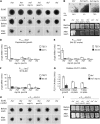Dysfunctional mitochondria modulate cAMP-PKA signaling and filamentous and invasive growth of Saccharomyces cerevisiae
- PMID: 23172851
- PMCID: PMC3567737
- DOI: 10.1534/genetics.112.147389
Dysfunctional mitochondria modulate cAMP-PKA signaling and filamentous and invasive growth of Saccharomyces cerevisiae
Abstract
Mitochondrial metabolism is targeted by conserved signaling pathways that mediate external information to the cell. However, less is known about whether mitochondrial dysfunction interferes with signaling and thereby modulates the cellular response to environmental changes. In this study, we analyzed defective filamentous and invasive growth of the yeast Saccharomyces cerevisiae strains that have a dysfunctional mitochondrial genome (rho mutants). We found that the morphogenetic defect of rho mutants was caused by specific downregulation of FLO11, the adhesin essential for invasive and filamentous growth, and did not result from general metabolic changes brought about by interorganellar retrograde signaling. Transcription of FLO11 is known to be regulated by several signaling pathways, including the filamentous-growth-specific MAPK and cAMP-activated protein kinase A (cAMP-PKA) pathways. Our analysis showed that the filamentous-growth-specific MAPK pathway retained functionality in respiratory-deficient yeast cells. In contrast, the cAMP-PKA pathway was downregulated, explaining also various phenotypic traits observed in rho mutants. Thus, our results indicate that dysfunctional mitochondria modulate the output of the conserved cAMP-PKA signaling pathway.
Figures






Similar articles
-
Cyclic AMP-dependent protein kinase regulates pseudohyphal differentiation in Saccharomyces cerevisiae.Mol Cell Biol. 1999 Jul;19(7):4874-87. doi: 10.1128/MCB.19.7.4874. Mol Cell Biol. 1999. PMID: 10373537 Free PMC article.
-
Crosstalk between cAMP-PKA and MAP kinase pathways is a key regulatory design necessary to regulate FLO11 expression.Biophys Chem. 2007 Jan;125(1):59-71. doi: 10.1016/j.bpc.2006.06.012. Epub 2006 Jun 27. Biophys Chem. 2007. PMID: 16863676
-
cAMP/PKA signaling balances respiratory activity with mitochondria dependent apoptosis via transcriptional regulation.BMC Cell Biol. 2010 Nov 25;11:92. doi: 10.1186/1471-2121-11-92. BMC Cell Biol. 2010. PMID: 21108829 Free PMC article.
-
Novel sensing mechanisms and targets for the cAMP-protein kinase A pathway in the yeast Saccharomyces cerevisiae.Mol Microbiol. 1999 Sep;33(5):904-18. doi: 10.1046/j.1365-2958.1999.01538.x. Mol Microbiol. 1999. PMID: 10476026 Review.
-
Glucose-stimulated cAMP-protein kinase A pathway in yeast Saccharomyces cerevisiae.J Biosci Bioeng. 2007 Oct;104(4):245-50. doi: 10.1263/jbb.104.245. J Biosci Bioeng. 2007. PMID: 18023794 Review.
Cited by
-
PKA regulatory subunit Bcy1 couples growth, lipid metabolism, and fermentation during anaerobic xylose growth in Saccharomyces cerevisiae.PLoS Genet. 2023 Jul 6;19(7):e1010593. doi: 10.1371/journal.pgen.1010593. eCollection 2023 Jul. PLoS Genet. 2023. PMID: 37410771 Free PMC article.
-
Conserved signaling modules regulate filamentous growth in fungi: a model for eukaryotic cell differentiation.Genetics. 2024 Oct 7;228(2):iyae122. doi: 10.1093/genetics/iyae122. Genetics. 2024. PMID: 39239926 Free PMC article. Review.
-
TOR complex 2-Ypk1 signaling is an essential positive regulator of the general amino acid control response and autophagy.Proc Natl Acad Sci U S A. 2014 Jul 22;111(29):10586-91. doi: 10.1073/pnas.1406305111. Epub 2014 Jul 7. Proc Natl Acad Sci U S A. 2014. PMID: 25002487 Free PMC article.
-
The Functional Role of eL19 and eB12 Intersubunit Bridge in the Eukaryotic Ribosome.J Mol Biol. 2016 May 22;428(10 Pt B):2203-16. doi: 10.1016/j.jmb.2016.03.023. Epub 2016 Mar 30. J Mol Biol. 2016. PMID: 27038511 Free PMC article.
-
Aggregate Filamentous Growth Responses in Yeast.mSphere. 2019 Mar 6;4(2):e00702-18. doi: 10.1128/mSphere.00702-18. mSphere. 2019. PMID: 30842272 Free PMC article.
References
-
- Brückner S., Mösch H. U., 2012. Choosing the right lifestyle: adhesion and development in Saccharomyces cerevisiae. FEMS Microbiol. Rev. 36: 25–58 - PubMed
-
- Carlucci A., Lignitto L., Feliciello A., 2008. Control of mitochondria dynamics and oxidative metabolism by cAMP, AKAPs and the proteasome. Trends Cell Biol. 18: 604–613 - PubMed
-
- Carrillo D., Vicente-Soler J., Gacto M., 1994. Cyclic AMP signalling pathway and trehalase activation in the fission yeast Schizosaccharomyces pombe. Microbiology 140(Pt 6): 1467–1472 - PubMed
Publication types
MeSH terms
Substances
LinkOut - more resources
Full Text Sources
Molecular Biology Databases

